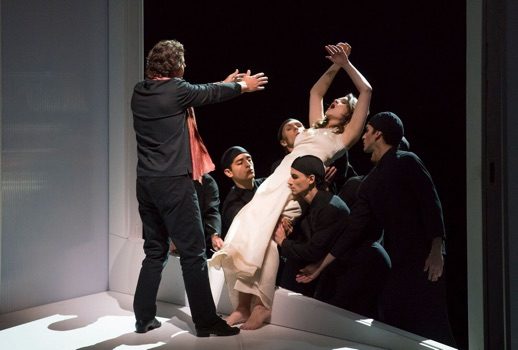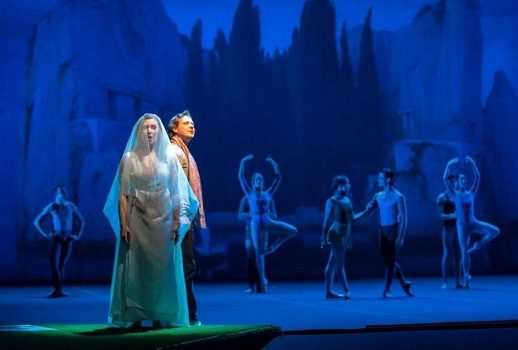

Lyric’s last production of the Gluck utilized the 1762 Italian version Orfeo ed Eurydice with countertenor David Daniels taking the title role. For Paris, the role was revised to the vocal category “haute-contre,” a lyric tenor whose voice sits exceptionally high, embodied here by the Russian tenor Dmitry Korchak.
The celebrated choreographer John Neumeier, director and chief choreographer of the Hamburg Ballet, here wears a number of hats—for this Orphee, he serves as Director and Choreographer as well as set, costume, and lighting designer. Neumeier’s conceit for this modernist, rather minimalist production is that Orphee begins the piece as a choreographer rehearsing in studio his new ballet.
Eurydice is the principal dancer, and is very late to rehearsal, to the annoyance of Orphee and his dancers. When she finally arrives, her behavior causes a quarrel with Orphee. She slaps him and furiously walks out. The next image we see is the wreckage of Eurydice’s car—she has driven it into a tree and been killed (here we see an actual wrecked red Mini Cooper and a barren tree). I must say that suddenly hearing the whines of ambulance sirens is quite jarring and seems completely out of place following Gluck’s austere music.
Then, there is a loud cellphone ring which had a number of audience members desperately checking their phones, only to find Orphee answering his phone to receive the news of Eurydice’s fate. And Orphee is comforted by Amour, here played as his assistant or stage manager. Much of this conceit works fairly well, though the setting seems something of an excuse to employ the dancers in the first act. The chorus is unseen, singing from the pit, so dancers take the roles of mourners bringing flowers to form a sort of tribute to Eurydice at the site of her accident.
It is at this point that I first questioned Neumeier’s directorial eye. As Amour comforts Orphee on a bench far down right on the stage, the dancers continue to move in mourning over Eurydice, creating an annoying split focus. The audience’s focus is continually pulled from one side of the stage to the other. It is one of the first rules of stage direction that the audience’s eye will be drawn to movement. There are several other moments of this in the second act.
Neumeier seems unsure whether he wants our focus on the dancers or on the principal singers.

He spun gorgeous, delicate pianissimi while having the power to handle Orphee’s emotional outbursts. He is also a solid presence on stage and acts the role with confidence and grace. I had forgotten what a “big sing” this role is, and fortunately Korchak has the requisite stamina, sounding fresh throughout. His way with Orphee’s great lament “J’ai perdu mon Eurydice” was particularly moving.
The Canadian soprano Andriana Chuchman is a lovely, clear-voiced Eurydice, quite moving in her second act laments. She also proves a fine dancer in her brief balletic sequences. Lauren Snouffer is a charming, tomboyish Amour, boldly declaring one of the major themes of the opera, that love will always triumph over death. Their voices blend superbly in the third act trio “Tendre amour”, a model of stylish singing.
It was a pleasure to see the fine Joffrey Ballet dancers inhabiting the Lyric stage, and it will be exciting to see what happens when Joffrey moves its performances to the Civic Opera House beginning in 2020. The dancers moved with astonishing grace, from writhing Hades beasts in “Dance of the Furies” to placid lovers in “Dance of the Blessed Spirits.”
Special kudos go to the three men embodying Cerberus, Edson Barbosa, Dylan Gutierrez and Alberto Velazquez, frightening yet sensual in their threatening of Orphee. But I found some of Neumeier’s choreography problematic. While exciting and athletic, the choreography seemed repetitive and fidgety, and I found my attention waning as the repetitions piled up. Occasionally it seemed we were watching two different productions, the sung one and the danced one. Only in the Hades scene did the dancing and singing seemed to blend to a unified whole.
Neumeier’s cool, modern mirrored panels shifted seamlessly between scenes, and his costumes, particularly for the dancers, brought needed color to the mainly grey, black, and white setting. The set element I enjoyed most was the use of Arnold Bockman’s painting “The Isle of the Dead”, coincidentally the title of the ballet that Orphee is creating for his principal dancer Eurydice.
The glittering audience greeted Korchak’s solo curtain call with a well-deserved chorus of bravos, and saved another huge ovation for the Joffrey dancers, the other principals and Mr. Neumeier, who embodied class and grace in his solo bow. I should report that the bulk of the audience had far fewer quibbles with the production than I did, and seemed to leave the theatre delighted and enthused.
Photos: Todd Rosenberg

























Comments